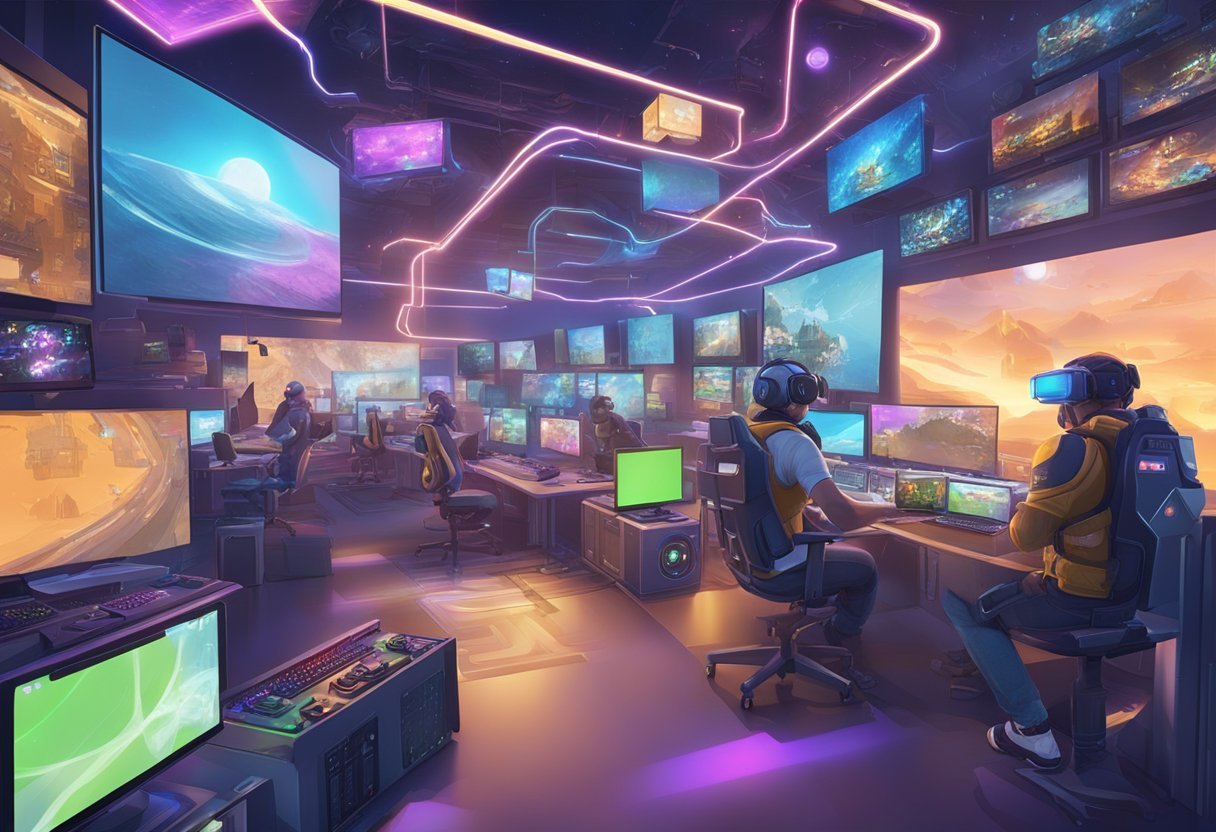The concept of a metaverse has been around for decades, but it is only recently that it has gained mainstream attention. The metaverse is a virtual world where people can interact with each other in real-time, and it has been the subject of many science fiction stories and movies. However, with the advent of technology, the metaverse is becoming a reality, and open-source software is playing a crucial role in its development.
Open-source software is software that is freely available for anyone to use, modify, and distribute. It is a collaborative effort where developers from all over the world contribute to the development of the software. Open-source software has been instrumental in the development of the internet, and it is now playing a critical role in the development of the metaverse. The metaverse is a complex system that requires a lot of different software components to work together seamlessly, and open-source software is making it possible to develop these components quickly and efficiently.
The development of the metaverse is still in its early stages, but it is clear that open-source software will play a crucial role in its development. With the help of open-source software, developers can collaborate and build the metaverse faster and more efficiently than ever before. As the metaverse continues to evolve, it is likely that open-source software will continue to be at the forefront of its development.
What is an open source metaverse?

An open source metaverse is a virtual world where users can interact with each other and digital objects in real-time. It is built on open source software, which means that anyone can access the code, modify it, and contribute to its development. The goal of an open source metaverse is to create a decentralized and democratic virtual world that is accessible to everyone.
How does an open source metaverse work?
An open source metaverse works by using a combination of virtual reality (VR), augmented reality (AR), and mixed reality (XR) technologies. Users can enter the metaverse using a VR headset or a mobile device and interact with other users and digital objects in real-time. The metaverse is built on a decentralized network of servers, which means that there is no central authority controlling it.
What are the best open source metaverse platforms?
There are several open source metaverse platforms available, including OpenSimulator, High Fidelity, and JanusVR. Each platform has its own strengths and weaknesses, and the choice of platform depends on the specific needs of the user. OpenSimulator is a popular choice for building virtual worlds, while High Fidelity is known for its high-quality graphics and support for VR headsets.
How can I get involved in open source metaverse development?
Getting involved in open source metaverse development is easy. Most platforms have active communities of developers who are willing to help newcomers get started. Users can contribute to the development of the metaverse by creating new digital objects, building virtual worlds, or improving the software itself.
What are the future of open source metaverses?
The future of open source metaverses is bright. As VR and AR technologies become more advanced and more affordable, the demand for virtual worlds is likely to increase. Open source metaverses offer a decentralized and democratic alternative to traditional virtual worlds, which could make them more appealing to users.
How does governance work in open source metaverses?
Governance in open source metaverses is typically decentralized. There is no central authority controlling the metaverse, and decisions are made by the community through a consensus-based process. Users can propose changes to the software or the virtual world, and these proposals are voted on by the community. This democratic approach to governance helps to ensure that the metaverse remains accessible and open to everyone.
Technical Aspects of Open Source Metaverse
Infrastructure and Technology
The infrastructure and technology behind open source metaverse are crucial in ensuring that users can interact seamlessly within the virtual world. Open source metaverse platforms provide a decentralized approach to virtual world building, allowing users to create, share and interact with each other in a secure and efficient manner.
One of the most important aspects of open source metaverse infrastructure is the use of blockchain technology. Blockchain technology provides a secure and transparent way of recording transactions and interactions within the virtual world. This technology helps to ensure that users can interact with each other in a secure and trustworthy environment.
Interoperability and Standards
Interoperability and open standards are also important technical aspects of open source metaverse. Open standards help to ensure that different virtual worlds can communicate and interact with each other seamlessly. This helps to create a more unified and connected virtual world.
Open source metaverse platforms like VRSpace use open standards like glTF and WebGL to load and render virtual content. This ensures that users can easily access and interact with virtual content from different sources.
Security Considerations
Security is a major concern in any virtual world, and open source metaverse is no exception. Open source metaverse platforms use a variety of security measures to ensure that users can interact with each other in a secure and trustworthy environment.
One of the most important security measures used in open source metaverse is the use of encryption. Encryption helps to ensure that user data is protected and secure from unauthorized access. Additionally, open source metaverse platforms use a variety of authentication and authorization mechanisms to ensure that only authorized users can access and interact with virtual content.
In conclusion, the technical aspects of open source metaverse are crucial in ensuring that users can interact with each other in a secure and efficient manner. Infrastructure, interoperability, open standards, and security are all important considerations that must be taken into account in order to create a successful and thriving virtual world.
Building and Engaging in the Open Source Metaverse

The open source metaverse is a network of different platforms, bodies, and technologies working together and embracing interoperability. Building and engaging in the open source metaverse involves creation and collaboration, user-generated content and avatars, and immersive experiences.
Creation and Collaboration
One of the main features of the open source metaverse is the ability for users to create and collaborate on content. This can be done through various tools and platforms, such as 3D modeling software and virtual world development kits. Open source software and standards are essential for creating an inclusive and accessible metaverse.
User-Generated Content and Avatars
User-generated content and avatars are a crucial part of the open source metaverse. Users can create and customize their avatars to represent themselves in the virtual world. They can also create and share content, such as buildings, objects, and landscapes. Open source software and standards ensure that user-generated content is accessible and can be shared across different platforms.
Immersive Experiences
The open source metaverse provides immersive experiences that allow users to interact with each other and the virtual environment. This can include virtual events, games, and simulations. Open source software and standards are essential for creating immersive experiences that are accessible to all users.
In conclusion, building and engaging in the open source metaverse involves creating and collaborating on content, user-generated content and avatars, and immersive experiences. Open source software and standards are essential for creating an inclusive and accessible metaverse.
Future of Open Source Metaverse

The concept of an open-source metaverse has gained momentum in recent years, with developers and enthusiasts exploring the potential of a decentralized, community-driven virtual world. While the idea of an open-source metaverse holds great promise, it also presents several potential challenges that must be addressed.
Potential Challenges
One of the main challenges facing the development of an open-source metaverse is the need for a robust and scalable infrastructure. As the metaverse grows in popularity and complexity, it will require significant resources to support its users and maintain its functionality. This includes everything from cloud computing and storage to networking and security.
Another challenge is the need for a strong governance model that can ensure the integrity and fairness of the metaverse. This includes issues such as content moderation, user privacy, and intellectual property rights. Without a clear and effective governance model, the metaverse could become a breeding ground for abuse and exploitation.
Role of AI and Blockchain
Artificial intelligence (AI) and blockchain technology are two key components that could play a significant role in the development of an open-source metaverse. AI can help to create more realistic and immersive virtual environments, while blockchain can provide a secure and transparent platform for transactions and ownership rights.
Futurewei, a company that specializes in AI and cloud computing, has already begun exploring the potential of an open-source metaverse. The company has developed a platform called OpenHarmony that aims to create a unified, decentralized ecosystem for the internet of things (IoT) and other applications. This platform could serve as a foundation for the development of an open-source metaverse.
The Global Impact
The development of an open-source metaverse could have a significant impact on the global economy and society as a whole. By creating a new virtual economy, the metaverse could provide new opportunities for entrepreneurs and content creators, while also challenging traditional business models and power structures.
However, the development of an open-source metaverse also raises important questions about issues such as digital sovereignty, data privacy, and social inequality. As the metaverse becomes more integrated into our daily lives, it will be important to ensure that it is developed in a way that benefits everyone, not just a select few.
In conclusion, the development of an open-source metaverse holds great promise for the future of virtual reality and the internet as a whole. However, it also presents several challenges that must be addressed, including infrastructure, governance, and the role of AI and blockchain. By working together to overcome these challenges, we can create a metaverse that is truly open, inclusive, and beneficial for all.
Frequently Asked Questions
What are some popular open source metaverse development tools?
There are several popular open source metaverse development tools available, including Unity3D, Unreal Engine, and Godot Engine. These tools provide developers with the ability to create immersive virtual environments, complete with 3D models, animations, and physics simulations.
What are some examples of open source Sims?
There are several open source Sims available, including OpenSimulator, SimAntics, and Simutrans. These Sims provide developers with the ability to create complex simulations of real-world environments, complete with realistic physics and AI.
How can I build my own metaverse using open source tools?
To build your own metaverse using open source tools, you will need to start by choosing a development platform. Once you have chosen a platform, you can begin creating 3D models, animations, and physics simulations to populate your virtual environment. You can also use scripting languages like Python or Lua to create custom behaviors and interactions within your metaverse.
Is there an open source game engine commonly used in metaverse development?
Yes, the Godot Engine is a popular open source game engine that is commonly used in metaverse development. It provides developers with a powerful set of tools for creating 3D games and simulations, including support for physics simulations, animation blending, and advanced scripting.
Are there any open metaverse platforms available?
Yes, there are several open metaverse platforms available, including OpenSimulator, High Fidelity, and Mozilla Hubs. These platforms provide developers with the ability to create immersive virtual environments that can be accessed from anywhere in the world using a web browser or virtual reality headset.
What are some sample projects for building a metaverse using open source tools?
Some sample projects for building a metaverse using open source tools include creating a virtual museum, a virtual art gallery, or a virtual shopping mall. These projects can be used to showcase the capabilities of open source metaverse development tools and provide users with a unique and immersive experience.




